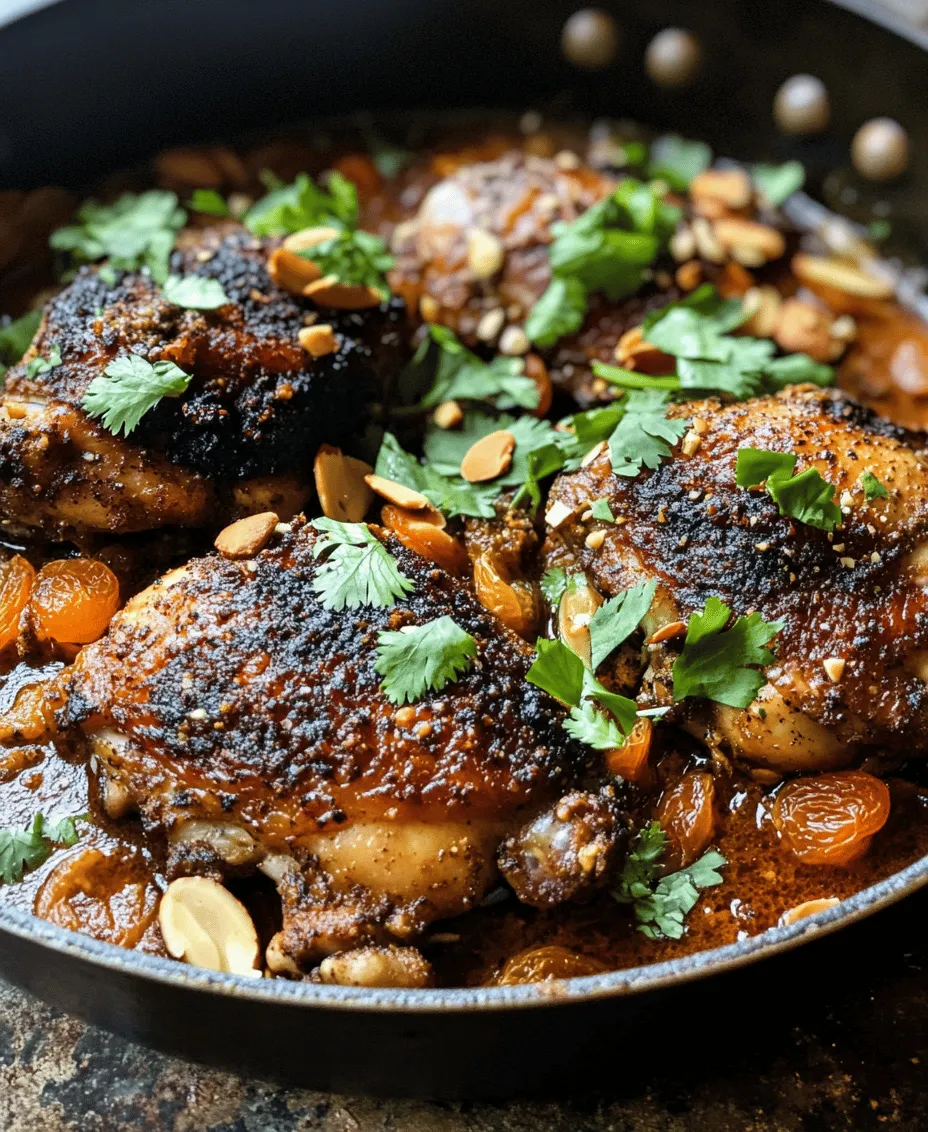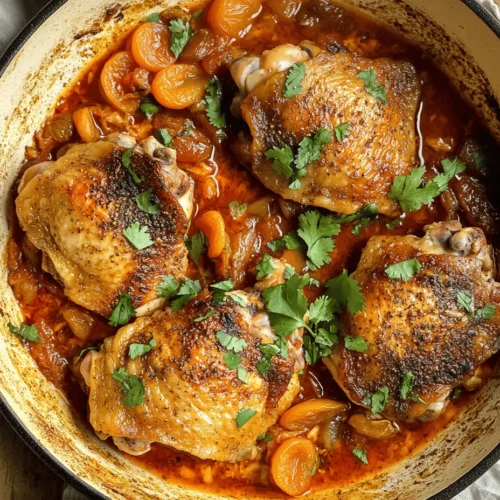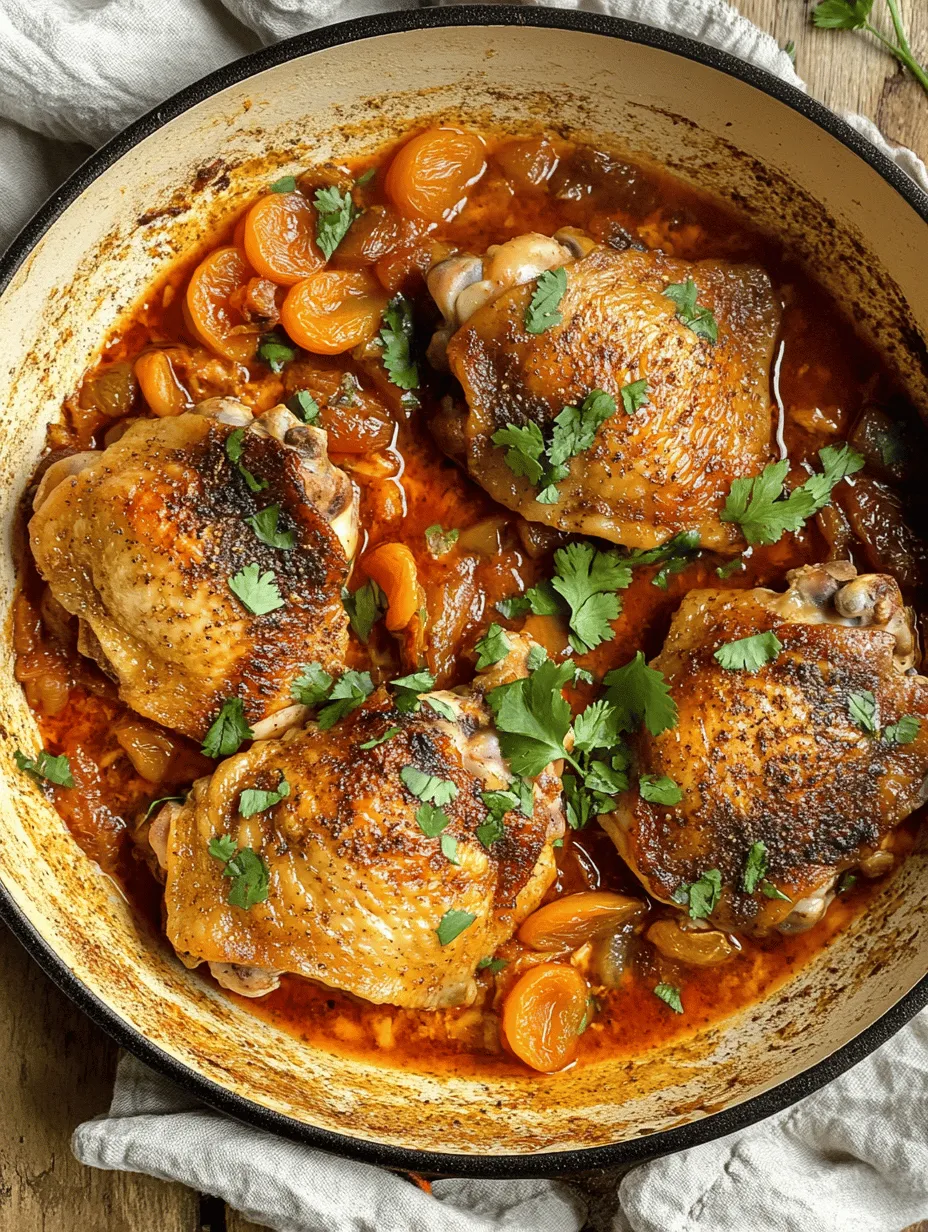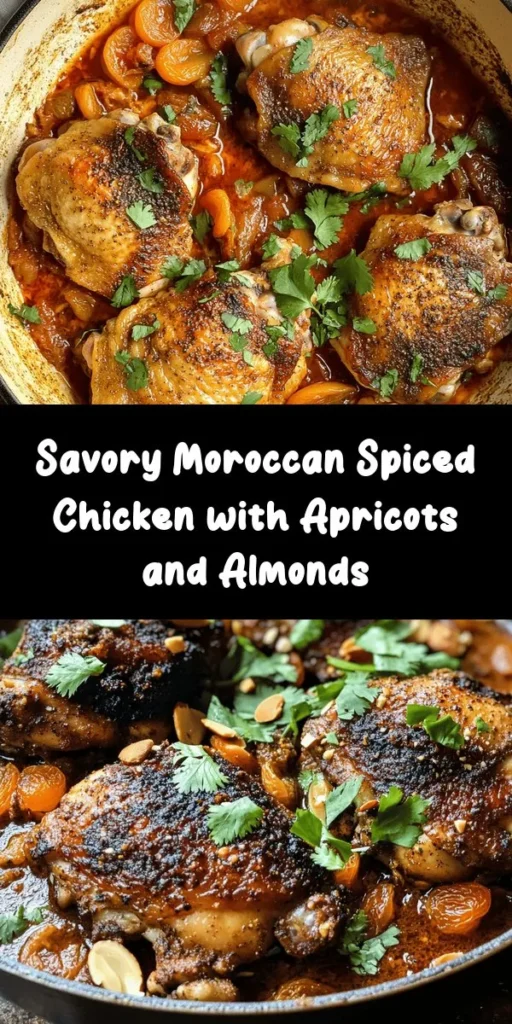Introduction
Step into the vibrant world of Moroccan cuisine, where spices dance in a medley of exotic flavors, and each dish tells a story of rich cultural heritage. Among the many culinary treasures this North African country has to offer, Moroccan Spiced Chicken stands out as a comforting yet adventurous choice. This dish not only tantalizes the taste buds but also elevates any dining experience, whether it’s a casual family dinner or a festive gathering with friends.
What makes Moroccan Spiced Chicken truly remarkable is the careful attention to marination. This essential step allows the chicken to absorb the unique blend of spices, creating a symphony of flavors that sing in every bite. From warm cumin to sweet cinnamon, the spices are the heart of this recipe, transforming simple ingredients into an unforgettable meal.
In this article, we’ll delve into the essence of Moroccan cuisine, explore the key ingredients that bring Moroccan Spiced Chicken to life, and guide you through the initial preparations for this delicious dish.
Understanding Moroccan Cuisine
Moroccan cuisine is a vibrant tapestry woven from a rich history of cultural influences, including Berber, Arab, and Mediterranean traditions. This fusion has given rise to a unique culinary style characterized by bold flavors, aromatic spices, and a love for fresh, wholesome ingredients. The use of spices in Moroccan cooking is not merely for seasoning; it’s an integral part of the culinary identity that defines this region.
Spices such as saffron, cumin, coriander, and cinnamon are staples in Moroccan kitchens, each playing a vital role in the flavor profiles of various dishes. These spices contribute not only to the taste but also to the visual appeal and aroma of the food, making every meal a sensory delight. Whether used in tagines, stews, or grilled meats, Moroccan spices create layers of complexity that can transport diners straight to the bustling souks of Marrakech or the serene landscapes of the Atlas Mountains.
The art of spicing is deeply rooted in Moroccan culture, often passed down through generations. Cooking is seen not just as a necessity but as a way to connect with family and friends, share stories, and celebrate life’s moments. This communal aspect of dining is reflected in the warmth of Moroccan hospitality, where food is at the center of gatherings.
Ingredients Breakdown
Creating the perfect Moroccan Spiced Chicken requires a thoughtful selection of ingredients that come together to form a harmonious dish. Here’s a detailed look at each component of this recipe:
Chicken Thighs: The Perfect Cut
When it comes to choosing the right cut of chicken for Moroccan Spiced Chicken, bone-in, skin-on chicken thighs are the ideal choice. This cut is favored for its rich flavor, moisture retention, and tenderness during cooking. The bone adds a depth of flavor, while the skin helps to lock in juices, resulting in succulent meat that practically melts in your mouth.
Unlike chicken breasts, which can dry out easily, thighs remain juicy and flavorful, making them perfect for marinating and slow cooking. Additionally, the higher fat content in chicken thighs allows them to absorb the spices more effectively, enhancing the overall taste of the dish. This makes chicken thighs not only a delicious option but also a practical one for those looking to create a truly satisfying meal.
The Role of Spices
The magic of Moroccan Spiced Chicken lies in its aromatic marinade, which features a carefully curated selection of spices. Each spice plays a pivotal role in building the dish’s flavor profile:
– Ground Cumin: Known for its warm, earthy flavor, cumin is a cornerstone of Moroccan cuisine. It adds depth and complexity, enhancing the savory notes of the chicken.
– Ground Coriander: With its citrusy undertones, coriander complements the earthiness of cumin. It brings brightness to the dish, balancing the flavors beautifully.
– Ground Cinnamon: This spice adds a hint of sweetness and warmth, reminiscent of Moroccan markets where spices are sold in vibrant displays. Cinnamon lends an aromatic quality that elevates the entire dish.
– Smoked Paprika: Infusing a subtle smokiness, smoked paprika adds both color and depth. Its rich flavor enhances the overall profile of the chicken, making each bite feel indulgent.
– Cayenne Pepper: For those who enjoy a bit of heat, cayenne pepper brings a spicy kick to the marinade. Just a pinch can elevate the dish without overpowering the other flavors.
Together, these spices create a complex and aromatic experience that is characteristic of Moroccan cooking, allowing the chicken to shine while enveloped in a warm embrace of flavor.
The Aromatic Base
No Moroccan dish is complete without the aromatic base of onions and garlic. These ingredients form the foundation of flavor in Moroccan Spiced Chicken, enhancing the dish’s complexity and richness.
When sautéed, onions become sweet and caramelized, releasing their natural sugars and adding a depth of flavor that complements the spices. Garlic, with its robust and pungent aroma, infuses the dish with a savory essence. Together, they create a fragrant base that elevates the chicken, allowing it to absorb the wonderful spices fully.
Sweet and Savory Elements
To create a delightful balance of flavors, Moroccan Spiced Chicken incorporates sweet and savory elements through the addition of dried apricots and almonds.
Dried Apricots: These dried fruits contribute a natural sweetness that contrasts beautifully with the spices. Their chewy texture and fruity flavor provide a pleasant surprise in each bite, making the dish more interesting and layered.
Almonds: Toasted almonds add a satisfying crunch and nutty richness, enhancing the overall texture of the dish. They also serve as a visual appeal, creating an inviting presentation that beckons to be enjoyed.
The combination of sweet and savory not only reflects the essence of Moroccan cuisine but also creates a well-rounded dish that is satisfying and memorable.
Preparing Moroccan Spiced Chicken
Preparing Moroccan Spiced Chicken involves a few crucial steps to ensure that the flavors meld beautifully and the chicken is perfectly cooked. Below is a detailed guide to help you navigate the initial preparations:
Marinating the Chicken
The first step in creating Moroccan Spiced Chicken is marinating the chicken thighs. This process is vital for allowing the spices to penetrate the meat, infusing it with an array of flavors.
1. Combine the Marinade: In a mixing bowl, combine the ground cumin, ground coriander, ground cinnamon, smoked paprika, cayenne pepper, minced garlic, and finely chopped onions. Add olive oil to create a paste-like consistency, ensuring that all the spices are well incorporated.
2. Coat the Chicken: Place the chicken thighs in a large resealable plastic bag or a shallow dish. Pour the marinade over the chicken, making sure each piece is thoroughly coated. Massage the marinade into the chicken to ensure even coverage.
3. Marination Time: Seal the bag or cover the dish with plastic wrap, and refrigerate for at least 2 hours, or preferably overnight. This extended marination time allows the spices to infuse deeply into the chicken, resulting in a more flavorful dish.
By following these initial steps, you will set the stage for a mouthwatering Moroccan Spiced Chicken that is sure to impress with its rich flavors and tender texture.
In the next section of this article, we will delve into the cooking methods that bring this dish to life, ensuring that every bite is bursting with the essence of Moroccan cuisine. Stay tuned for more exciting details on how to complete this culinary journey!

Marination Process for Maximum Flavor
Marinating is a crucial step in achieving a flavorful Moroccan Spiced Chicken. The marinade, consisting of a blend of spices such as cumin, coriander, paprika, and cinnamon, creates a depth of flavor that permeates the chicken. To maximize flavor infusion, it’s essential to marinate the chicken for at least 2 hours, but overnight is ideal. This extended time allows the spices to penetrate the meat fully, resulting in a tender, juicy chicken that is bursting with flavor.
When marinating, always ensure that you coat the chicken evenly with the marinade. You can use a resealable plastic bag or a glass container to help distribute the marinade thoroughly. For added flavor, consider puncturing the chicken with a fork or knife in a few places; this will allow the marinade to seep into the meat more effectively.
Searing for Flavor
Once your chicken has marinated, the next step is searing it. Searing is a technique that involves cooking the meat at a high temperature to create a crispy outer layer, enhancing both flavor and texture. This process relies on the Maillard reaction, which occurs when proteins and sugars in the meat react under heat, resulting in a rich, complex flavor profile.
To sear your chicken, heat a generous drizzle of olive oil in a large oven-safe skillet over medium-high heat. Once the oil is shimmering, carefully place the marinated chicken in the skillet, ensuring not to overcrowd the pan. Sear each piece for about 4-5 minutes on each side or until a golden-brown crust forms. This step not only adds flavor but also helps to lock in juices, ensuring the chicken remains moist during baking.
Sautéing Aromatics
After searing the chicken, it’s time to build the base flavor of your dish by sautéing aromatics. Begin with finely diced onions and minced garlic. The onions should be cooked until they are translucent and softened, which typically takes about 3-4 minutes. The aroma should be inviting, signaling that they are ready for the next step.
Add the minced garlic and sauté for an additional minute, stirring frequently to prevent burning. Garlic cooks quickly and can turn bitter if overcooked. The combination of sautéed onions and garlic serves as a flavorful backdrop for the chicken, enhancing its taste and providing a fragrant aroma that fills your kitchen.
Combining Ingredients
Once the aromatics are ready, it’s time to combine them with the rest of the ingredients. Start by carefully adding the reserved marinade into the skillet, scraping up any brown bits from the bottom of the pan, which are packed with flavor. Then, pour in your chicken broth and add the chopped apricots. The broth will create a luscious sauce while the apricots add a touch of sweetness that balances the spices in the chicken.
Stir everything together, allowing the mixture to come to a gentle simmer. This step ensures that the flavors meld beautifully before the dish is finished in the oven.
Baking to Perfection
To finish cooking your Moroccan Spiced Chicken, transfer the skillet to a preheated oven set at 375°F (190°C). Baking the chicken allows it to cook through evenly while maintaining moisture. Depending on the size of your chicken pieces, the baking time will vary but generally takes about 20-30 minutes.
To check for doneness, use a meat thermometer. The internal temperature should reach 165°F (75°C) to ensure the chicken is fully cooked. Additionally, the juices from the chicken should run clear when pierced with a fork. You want the chicken to be tender yet firm, ensuring it retains its shape while being succulent.
Serving Suggestions
When it comes to serving Moroccan Spiced Chicken, there are several delightful pairings that complement the dish perfectly.
– Couscous: This North African staple is a fantastic option, as its light, fluffy texture absorbs the rich sauce from the chicken, making each bite flavorful. You can enhance your couscous by adding herbs, nuts, or dried fruits for additional depth.
– Rice: A simple side of steamed or seasoned rice works beautifully, providing a neutral base that allows the spiced chicken to shine.
– Fresh Salads: A refreshing salad with greens, cucumbers, and tomatoes drizzled with a light vinaigrette adds a crisp contrast to the savory chicken. The freshness of the salad balances the rich spices, creating a well-rounded meal.
Each of these sides contributes unique flavors and textures that enhance the overall dining experience, allowing the Moroccan Spiced Chicken to take center stage.
Nutritional Benefits
Moroccan Spiced Chicken is not only delicious but also packed with nutritional benefits.
– Protein Content: The chicken serves as an excellent source of lean protein, essential for muscle repair and overall body function.
– Healthy Fats: The use of olive oil adds healthy fats, which are beneficial for heart health and help to absorb the fat-soluble vitamins present in the dish.
– Fiber: Apricots, a key ingredient in this recipe, are a good source of fiber, promoting digestive health and adding a natural sweetness that complements the spices.
– Vitamins and Minerals: Fresh herbs used in the marinade, such as cilantro or parsley, provide vitamins A, C, and K, as well as essential minerals, enhancing the overall health profile of the dish.
Conclusion
Moroccan Spiced Chicken stands out as a vibrant and flavorful dish that transports you to the heart of Moroccan culture with every bite. The careful preparation process—from marination to searing, sautéing, and baking—ensures that the chicken is not only packed with flavor but also tender and juicy.
This dish is an invitation to explore the rich culinary landscape of Morocco, complete with its warm spices and comforting ingredients. As you experiment with this recipe, consider sharing your own experiences and variations. Whether you’re hosting a dinner party or enjoying a cozy family meal, Moroccan Spiced Chicken is sure to impress and satisfy, bringing a taste of North Africa to your dining table.



